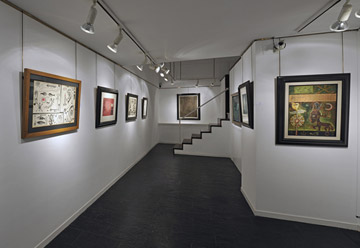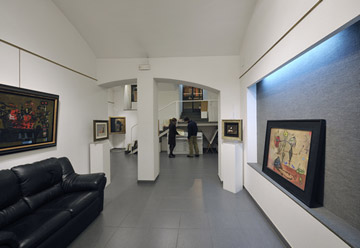- Amat, Frederic
- Amat, Gabriel
- Arranz Bravo
- Arroyo
- Barbara
- Barcelo
- Bartolozzi
- Bea
- Becquer
- Benet
- Bird
- Bores
- Brinkmann
- Brossa
- Cardenas
- Carral
- Casas
- Castillo
- Chancho
- Cisquella
- Clave
- Corbero
- Corneille
- Croft
- Cuixart
- Domingo
- Fabres
- Farreras
- Feito
- Fenosa
- Forteza
- Genovart
- Gimeno
- Gonzalez
- Gonzalo
- Graner
- Granyer
- Grau
- Grau Sala
- Gudiol
- Guinovart
- Hernandez Mompo
- Hernandez Pijuan
- Jorn, Asger
- Junyent, Oleguer
- Lam
- Llena
- Lloveras
- Lopez Ramon
- Marin
- Marsans
- Marsillach
- Marti Alsina
- Matilla
- Meifren
- Menchu Gal
- Meseguer
- Mir
- Mira
- Miro
- Moore
- Moragas
- Munoz
- Noland
- Olive
- Palazuelo
- Palencia
- Pazos
- Perejaume
- Perez Villalta
- Picasso
- Plantalech
- Plasencia
- Plensa
- Ponç
- Puig
- Rafols Casamada
- Ramis
- Rasero
- Rebull
- Riera i Arago
- Rivera
- Roca Sastre
- Roig
- Roig Soler
- Rossell
- Rueda
- Saura
- Serra
- Sicilia
- Solano
- Subirachs
- Sunyer
- Tamayo
- Tapies
- Tharrats
- Togores
- Torres Garcia
- Ubeda
- Ucles
- Valdes
- Valls
- Vedova
- Viladecans
- Vilagrasa
- Villa
- Zao Wou-ki
Artists +
Hours
Subirachs
Josep Maria Subirachs (1927-2014) was a renowned contemporary sculptor who consciously created his own structured and solid language, akin to a universal idiom.
Born on March 11, 1927, in Barcelona, Subirachs began his artistic journey as an apprentice in E. Monjo’s workshop (1942-1947) and later became a free student at the "Escola de Belles Arts" in Barcelona (1945). His true mentor was Enric Casanovas (1947-1948), from whom he inherited a Mediterranean-style characterized by inspiration from Maillol. At the age of twenty-one, Subirachs held his first solo exhibition at the Casa del Llibre in Barcelona. His time in Paris (1951) and subsequent residence in Belgium (1954-1956) contributed to his professional development and a diverse understanding of the visual arts in the latter half of the 20th century.
In his quest for personal identity, Subirachs’ Mediterranean upbringing led to an expressionism showcased in the early Salons d’Octubre in Barcelona (1949-1957) with his work "Europa," where he exhibited alongside artists like Cuixart, Guinovart, Ponç, Ràfols Casamada, Tàpies, and Tharrats, among others. His work quickly transitioned into a process of schematization and deformation that culminated in abstraction. Notable from this period are "Forma 212" and "Evocació Marinera," the first two abstract sculptures placed outdoors in the city of Barcelona. In these works, Subirachs delved into his distinctive treatment of textures, one of his preferred methods for creating contrasts and expressiveness.
In 1959, he received the commission to sculpt the facade and doors of the Sanctuary of the Virgin of the Camino in León, a work that introduced a figurative parenthesis in his creative line. These slender and schematic bronze sculptures hinted at his subsequent evolution toward a neo-figurativism, blending figure and abstraction in a highly personal manner. In this phase, Subirachs employed the concave-convex dialectic in works where the void acquired its own space in contrast to the mass. Notable from this period is the monument to Narcís Monturiol (1963) in Barcelona, the first sculpture placed in a public space conceived in the style of "new figuration."
His creations garnered considerable public recognition, leading to significant commissions such as the facade of Barcelona City Hall (1969), Monument to Mexico in Mexico City (1968), the Olympic monument in Lausanne (1983), the sculptural covering of the Passion facade of the Sagrada Familia in Barcelona (from 1986 to the present), Union of East and West in Seoul (1989), and the monument to Francesc Macià in Plaça Catalunya, Barcelona (1991).
Subirachs worked with a wide range of materials, including terracotta, bronze, wood, iron, stone, fibercement, concrete, marble, copper, glass, aluminum, ivory, and steel. As a printmaker, he explored techniques such as etching, lithography, serigraphy, linoleum, and drypoint.
His work is characterized by a mastery of technique and meticulous formalism. Subirachs was fascinated by mythology rooted in Greco-Latin, Jewish, or Christian traditions, often incorporating classical elements like caryatids, sphinxes, capitals, niches, moldings, obelisks, hydrias, pyramids, and balustrades. Conceptually, he leaned towards irony, visual paradox, eroticism, and contrasts. He consciously created his language, structured and solid, as if it were a universal idiom. Undoubtedly, Subirachs stands as one of the great creators of our time.





